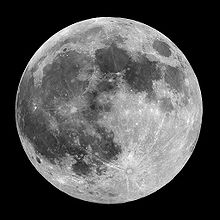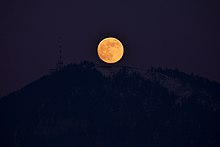Full moon
Full moon ( astronomical symbol :) ![]() is the point in time at which the sun and moon are in opposition to each other, i.e. in opposite directions when viewed from the earth . The side of the moon facing the earth is then completely illuminated by the sun and shines brightly, provided there is no lunar eclipse ; this occurs through the darkening earth's shadow when the moon is in the plane of the earth's orbit ( ecliptic ).
is the point in time at which the sun and moon are in opposition to each other, i.e. in opposite directions when viewed from the earth . The side of the moon facing the earth is then completely illuminated by the sun and shines brightly, provided there is no lunar eclipse ; this occurs through the darkening earth's shadow when the moon is in the plane of the earth's orbit ( ecliptic ).
In contrast, a new moon is when the moon is in conjunction between the sun and earth . If the moon is in the ecliptic plane , a solar eclipse can occur.
properties
A more precise definition is: "A full moon is the point in time at which the ecliptical geocentric longitude of the moon is 180 ° greater than the ecliptical geocentric longitude of the sun."
Here is geocentric : from a hypothetical observer in the center of the Earth seen. The full moon therefore takes place worldwide at the same time (which however corresponds to different times in different time zones ). When observing from the earth's surface, the point in time and the sight of the full moon depends to a small extent, imperceptibly on the location of the real observer.
When the moon is full, the moon reaches its maximum brightness and has an apparent brightness of around −12.5 to −13 mag. Compared to the light of the full moon , sunlight is about 400,000 times as bright; Compared to the light of a starry night sky , the full moon is about 250 times as bright. The brightness of the full moon fluctuates due to the elliptical orbits of the earth and moon. If the earth is particularly close to the sun ( perihelion ) and at the same time the moon is at its closest point to the earth ( perigee ) , the full moon is about 22 percent brighter than in the opposite case, when both distances are maximum. In September 2006 and March 2010 the full moon was very close to perigee, such constellations only occur about every nine years. The moon culminates at midnight on the day of the full moon . At this point in time, the sun is at its lowest point in the sky.
Special terms
For the full moons entering the perigee of the moon, exaggerated word creations like super full moon were put into circulation by the media . In the English language, the term blue moon originated for the occurrence of a second full moon in a month or a third full moon within a season . Full moons in June are also known as strawberry moons .
Under the Harvest Moon ( English harvest moon ) is not only an old name for the month of August understood but also an effect to the beginning of fall occurs. The apparent path that the moon takes against the background of the starry sky is very flat over the eastern horizon at this time of year. This means that in the days around the full moon, the time of the moon rise is only slightly shifted. The result is several nights with bright moonlight in a row. Before the introduction of modern agricultural machinery equipped with lighting, this effect made it possible to continue harvesting into the night if the weather was appropriate .
Others
Effects on Christmas trees are attributed to the full moon . A harvested tree should be able to keep its needles longer if it was harvested during the full moon or a few days before. However, such an effect cannot be scientifically proven.
See also
Web links
Individual evidence
- ↑ Lighting parameters , ron.mur.at (PDF, p. 5; 1.0 MB).
- ↑ The moon becomes a super moon ( Memento from November 13, 2016 in the Internet Archive ) In: Südostschweiz from November 11, 2016.
- ↑ Stefan Deiters: What makes the harvest moon so special. In: Astronews.com. September 17, 2013, accessed September 28, 2015 .
- ↑ Damond Benningfield: Stardate: Harvest Moon. Deutschlandfunk, September 26, 2007, accessed on September 28, 2015 .
- ↑ Moon trees are the best - In Krina, Christmas trees are felled around the last full moon. www.mz-web.de , December 8, 2017, accessed on December 22, 2019 .
- ↑ a b Culture: Hitting Christmas trees under a full moon? www.dw.com , December 18, 2003, accessed December 22, 2019 .
- ↑ Serious and bizarre things about the Alpine Christmas tree: O Christmas tree & tinsel syndrome. www.br.de , December 21, 2019, accessed on December 22, 2019 .


